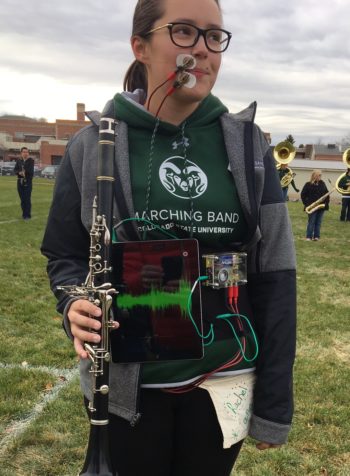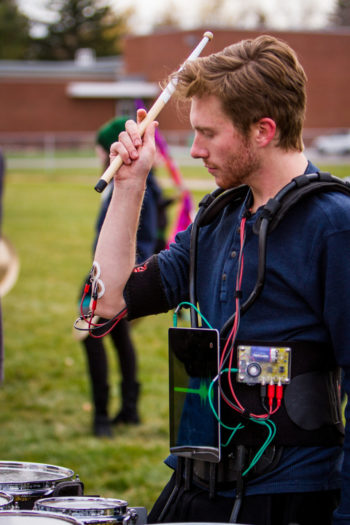Rachel Lana loves to play the clarinet, but when she developed tendinitis in high school from playing the instrument she wondered what she could do to treat the painful condition.
Beyond physical therapy, the only treatment advice she got was to simply stop playing the clarinet and rest. She was not happy.

“I was told to consider putting down the instrument for a year,” said the Fort Collins, native now a sophomore at CSU. “As a musician, you can’t just put down your instrument for a few weeks. There are concerts, recitals and practicing that demand a lot of work that do not allow a lot of down time.
“The physical therapist I worked with knew that I couldn’t simply not play my clarinet for a few months, so we worked around that to help me through my treatment while allowing me to continue to do what I was so passionate about.”
Lana started at CSU as a music education major, but eventually switched majors so she could pursue another interest – health and exercise science. She also made time to pursue her musical passion in the renowned CSU Marching Band.
True loves: science and music
And that gave her an idea: How could she combine her passions to come up with potential solutions for musicians dealing with muscle-related ailments like tendinitis. And that’s when she heard about the Muscles Alive! program – a project of health and exercise science professor Brian Tracy.
“When I first heard about Dr. Tracy’s Muscles Alive! program I started looking into it and saw countless videos showing people being fascinated by seeing their muscles work while they were performing everyday tasks,” Lana said. “I immediately thought the marching band would be a great place to show people how their muscles work.”
Tracy, director of the Neuromuscular Function Laboratory, created Muscle Alive! as a neuroscience educational outreach program. The program uses hands-on, kid-friendly equipment to perform experiential demonstrations to teach fourth through 12th graders about how their brain communicates with their muscles and how their muscles communicate with their brain.
Lana talked to Tracy about using Muscles Alive! technology to track muscle movement and, perhaps, offer clues about how musicians’ health issues might be addressed. Many students have come up with their own ideas for illustrating muscle connection to the brain – something Tracy fully embraces.
Students taking ownership
“A student who comes up with their own idea will have more ownership over that idea; it makes it a more immersive and meaningful experience for that student,” Tracy said. “(Rachel’s) is the type of project that gets me excited, seeing a student taking ownership of their own education. I can’t tell you how many times I’ve been geeking-out with students and getting just as excited about a project like this one. To me, that’s a really powerful thing.”

Lana enlisted Chase Hildebrandt, a sophomore music education major who graduated from Loveland High School, to help with the project. Hildebrandt plays the tenor drums – a 35-pound set of five that makes every performance a workout – and was a perfect subject for Lana’s project.
Electrodes were attached to Hildebrandt’s forearms for the drumming. The muscle signals were amplified with a device from Dr. Tracy’s neuroscience education collaborators at Backyard Brains, Inc., and then displayed using a wearable iPad-based system. For Lana, electrodes were placed over the muscles that control her mouth and lips.
Lana hopes to take what she’s learned and use it to help herself and her fellow musicians stay healthy.
‘Nerding-out’
“What a better way to blend the two things I’ve always been passionate about – music and science?” she said of the project. “I definitely have a lot of nerding-out moments when I talk about this. It’s not just STEM, it’s not just something out of liberal arts. I believe we are a combination of all our interests. To combine my greatest interests is a tremendous feeling.”